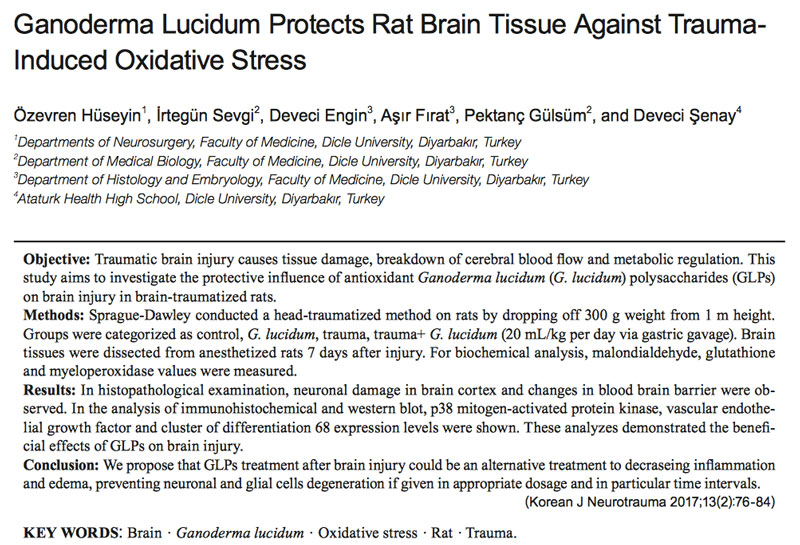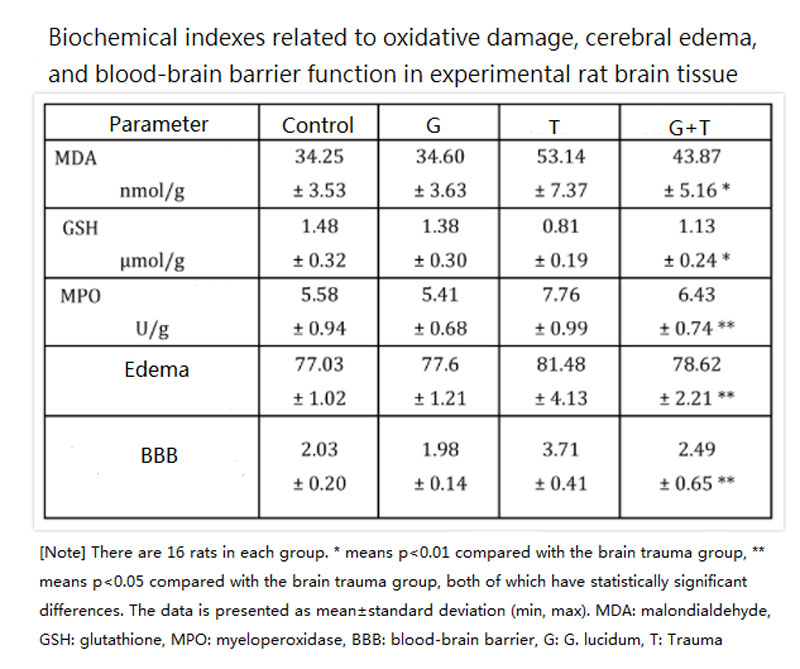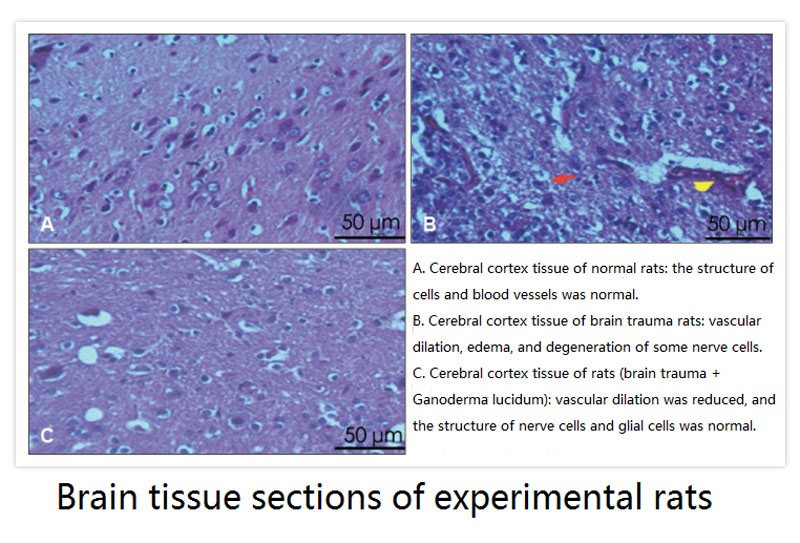2017년 10월/Dicle University/대한신경외상학회지
글/ 우팅야오

과거에, 사고로 인해 외상성 뇌손상을 입은 사람도 있다고 들었습니다.. 정기적인 진료 외에도, 그들도 많이 가져갔어영지버섯. 결과적으로, 회복 속도와 효과는 기대 이상이었습니다.. 63호 (봄 2014) of “건강한 영지” 미생물문화교육재단에서 발행한 6건의 실제 활용사례도 소개됐다.영지버섯 교통사고로 인한 트라우마를 되돌리기 위해.
~이다영지버섯 그래서 “마법 같은”? 에 발표된 보고서 “대한신경외상학회지” (한국신경외상학회지) 10월 터키 Dicle 대학에서 2017 동물실험을 통해 다당류 추출물이영지버섯 자실체는 실제로 뇌 외상의 회복을 가속화할 수 있습니다, 그 작용 메커니즘은 산화 스트레스를 줄이고 염증을 늦추는 것과 관련이 있습니다.
연구진은 인공적인 방법을 사용하여 “높이에서 떨어지는” 쥐에게 뇌 손상을 일으키기 위해. 그 중 절반 (16 쥐) 아무런 치료도 받지 않았다 (뇌 외상 그룹). 나머지 절반 (뇌외상 +영지버섯 그룹) 먹였다영지버섯m 주어진 일일 복용량 20 체중 1kg당 mL 30 트라우마가 발생한 지 몇 분 후 (각 mL의영지버섯 물 추출물에는 2 다당류 mg). 쥐의 뇌 외상은 7일 후에 평가됩니다.. 실험에는 일반 쥐도 사용되었습니다. (대조군) 그리고 일반 쥐에게영지버섯 다당류(영지버섯 그룹) 이전 두 그룹과 비교하기 위해.
뇌출혈이 염증을 일으킬 수 있다, 뇌의 산화압을 증가시킨다 (항산화 효소가 감소합니다, 자유 라디칼의 수가 증가합니다), 그리고 부종을 일으킬 수도 있습니다 (뇌조직을 압박해 손상시키는 것). 원래의 혈액뇌장벽 (혈관과 뇌 사이의 자연 장벽으로 이물질이 뇌로 들어가는 것을 차단할 수 있습니다.) 도 파괴될 것이다, 더 많은 백혈구가 뇌에 침투하거나 뇌 감염을 유발합니다., 염증을 더욱 심각하게 만드는.
이러한 상태는 외상으로부터 뇌 조직을 회복하는 데 도움이 되지 않습니다.. 하지만 본 보고서의 동물실험 결과에 따르면, 뇌 손상을 입은 쥐를 치료한 후영지버섯 7일 동안의 다당류, 뇌 조직은 자유라디칼에 의해 덜 손상됩니다 (MDA 감소), 뇌의 활성 산소를 중화시키는 항산화 효소 GSH가 증가합니다., 백혈구 염증은 덜 심각합니다. (퍼옥시다제 MPO의 분비가 적습니다.), 뇌부종도 많이 좋아졌습니다, 혈액뇌장벽의 투과성도 정상에 가깝습니다. 모든 값이 아무런 치료도 받지 않은 뇌 외상을 입은 쥐의 값과 크게 다릅니다. (아래 표를 참조하세요).

게다가, 대뇌피질의 조직 단면을 보면 알 수 있다.영지버섯 다당류는 혈관 확장과 부종을 개선할 수 있습니다., 신경 세포를 복구, 손상된 뇌의 회복을 가속화합니다. (아래와 같이). 대뇌피질은 뇌의 바깥층을 감싸고 있는 수많은 주름으로 연결된 피부 같은 구조를 말한다.. 더 높은 수준의 감정과 사고 능력을 담당합니다.. 그러므로, 이 지역의 회복은 매우 중요합니다.

연구원들은 또한 쥐의 뇌 조직에서 세 가지 다른 중요한 지표를 테스트했습니다., 단백질 키나아제 p38 MAPK 포함, 이는 염증과 긍정적인 관련이 있습니다., 혈관 내피 성장 인자 (VEGF), 혈관 구조를 복구하는 데 필요한, 및 소교세포, 손상된 신경세포와 병원균을 제거하는 역할을 담당하는.
그것은 발견되었다, 뇌 손상을 입은 쥐에 비해 아무것도 먹지 않은 쥐영지버섯 다당류, p38 MAPK의 활성은 뇌 손상을 입은 쥐에서 여전히 검출되었지만영지버섯 다당류, (반응이 진행 중이지만 조절되었으며 악화되지 않았음을 나타냅니다.), 혈관 내피 성장 인자와 소교세포가 크게 증가했습니다., 것을 나타내는영지버섯 다당류는 대뇌 혈관과 뇌신경의 복구 및 재건에 유익합니다..
위의 실험결과는 이 약의 지속적인 투여에 따른 효과를 보여주고 있다.영지버섯 뇌 손상 후 7일 동안 다당류 섭취. 연구자들은 적절한 복용량이영지버섯 다당류는 뇌 외상이 발생한 후 보조 요법으로 사용될 수 있습니다, 염증 및 뇌부종 완화에 많은 도움이 될 것입니다., 또는 신경 세포와 신경교 세포를 보호하기 위한 것입니다.
[원천] 오제브렌 H, 외. Ganoderma Lucidum 은 외상으로 인한 산화 스트레스로부터 쥐의 뇌 조직을 보호합니다. 한국J 신경외상. 2017; 13(2): 76-84.
끝
저자 소개 / 씨. 우팅야오
Wu Tingyao가 직접 보고해 왔습니다.영지버섯 이후의 정보 1999. 그녀는 다음의 저자입니다.Ganoderma로 치유 (4월 인민의학출판사에 게재 2017).
★ 이 글은 저자의 단독 승인 하에 게재되었습니다.
★ 위 작품은 복제할 수 없습니다, 저작자의 허락 없이 발췌하거나 다른 방법으로 사용한 경우
★ 위의 내용을 위반한 경우, 저자는 관련 법적 책임을 추구할 것입니다.
★ 이 기사의 원문은 Wu Tingyao가 중국어로 작성하고 Alfred Liu가 영어로 번역했습니다.. 번역 내용에 차이가 있는 경우 (영어) 그리고 원본 (중국인), 원래 중국어가 우선합니다. 독자들이 궁금한 점이 있으면, 원작자에게 연락주세요, 양. 우팅야오.



